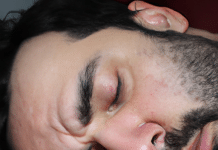Sleep paralysis is a fascinating phenomenon that occurs when we are caught between the hazy realms of sleep and wakefulness. During this strange occurrence, our body is temporarily paralyzed, leaving us unable to move or speak, while our mind remains conscious and fully aware of our surroundings. It is as if our body has hit the pause button, leaving us in a somewhat perplexing state. Dive into the depths of this intriguing experience and learn more about what causes sleep paralysis and how it affects us. Sleep paralysis is a sleep disorder characterized by a temporary inability to move or speak while falling asleep or waking up. It is a frightening experience that can leave individuals feeling trapped and helpless. During episodes of sleep paralysis, the brain and body are caught in a state between wakefulness and sleep, resulting in a loss of muscle control. This phenomenon can last from a few seconds to several minutes, leaving individuals feeling disoriented and anxious.
Review contents
Definition of Sleep Paralysis
Sleep paralysis refers to the temporary paralysis of muscles that occurs during transitions between sleep stages. It is most commonly experienced as individuals are falling asleep or waking up. In a normal sleep cycle, the brain sends signals to relax muscles and inhibit movement to prevent acting out dreams during REM sleep. However, in sleep paralysis, this process becomes disrupted, resulting in the individual being aware of their surroundings but unable to move or speak.
Prevalence of Sleep Paralysis
Sleep paralysis is more common than most people realize. It is estimated that between 8% to 50% of the general population has experienced at least one episode of sleep paralysis in their lifetime. While the exact prevalence rates vary across different cultures and populations, sleep paralysis is a widely experienced phenomenon that affects individuals of all ages and backgrounds.
Causes of Sleep Paralysis
The exact cause of sleep paralysis is not fully understood. However, there are several factors that are believed to contribute to its occurrence. Sleep deprivation, irregular sleep schedules, and a disrupted sleep-wake cycle are common triggers for sleep paralysis. Additionally, other sleep disorders such as narcolepsy and sleep apnea have been found to be associated with an increased risk of experiencing sleep paralysis.
Types of Sleep Paralysis
There are two main types of sleep paralysis: isolated sleep paralysis and recurrent sleep paralysis. Isolated sleep paralysis refers to single occurrences of sleep paralysis, often happening as a result of sleep deprivation or disrupted sleep patterns. Recurrent sleep paralysis, on the other hand, involves repeated episodes of sleep paralysis over an extended period of time. Recurrent sleep paralysis is often associated with other sleep disorders and may require medical intervention for management.
Symptoms of Sleep Paralysis
Inability to Move or Speak
One of the primary symptoms of sleep paralysis is the temporary loss of muscle control. During an episode, individuals find themselves unable to move any part of their body, including their arms and legs. This can be an incredibly distressing experience, as individuals may feel as though they are trapped or paralyzed. The inability to speak is also commonly reported during sleep paralysis episodes, adding to the feeling of helplessness.
Feeling of Pressure on Chest
Many individuals who experience sleep paralysis also report a feeling of pressure or weight on their chest. This sensation can make it difficult to breathe properly, leading to heightened anxiety and panic. While the exact cause of this sensation is not yet known, it is believed to be linked to the body’s transition between sleep stages, as well as the activation of the body’s stress response system during sleep paralysis.
Hallucinations
Another common symptom of sleep paralysis is the occurrence of vivid hallucinations. These hallucinations can take various forms, including seeing dark figures or shadows in the room, hearing strange noises, or feeling a presence in the room. These hallucinations can be extremely realistic and often contribute to the fear and anxiety experienced during sleep paralysis episodes. It is important to note that these hallucinations are not caused by mental illness or psychosis.
Sense of Impending Doom
A sense of impending doom is frequently reported by individuals experiencing sleep paralysis. This intense feeling of fear and dread can be overwhelming, often leading to panic and an increased heart rate. The combination of the physical symptoms and the psychological distress can make sleep paralysis a highly distressing experience for those who go through it.
Diagnosis and Treatment of Sleep Paralysis
Medical Evaluation and Sleep Study
When experiencing sleep paralysis and seeking a diagnosis, it is important to consult with a healthcare professional. They will conduct a thorough medical evaluation, which may include a review of your sleep history, physical examination, and blood tests. In some cases, a sleep study may be recommended to monitor brainwave activity, muscle movement, and other physiological markers during sleep.
Managing Sleep Paralysis
While there is no cure for sleep paralysis, there are strategies that can help individuals manage and reduce the frequency and intensity of episodes. Maintaining a regular sleep schedule, practicing good sleep hygiene, and managing stress can all contribute to better overall sleep quality and a reduced likelihood of experiencing sleep paralysis. Additionally, relaxation techniques such as deep breathing and meditation can be helpful in managing anxiety during episodes.
Medication Options
In some cases, healthcare professionals may prescribe medication to manage sleep paralysis symptoms. Medications such as selective serotonin reuptake inhibitors (SSRIs) or antidepressants may be used to treat underlying sleep disorders or to address anxiety and depression associated with sleep paralysis. However, it is important to discuss potential risks and benefits with a healthcare professional before starting any medication.
Sleep Paralysis and Other Sleep Disorders
Association with Narcolepsy
Sleep paralysis is often associated with narcolepsy, a neurological disorder that affects the brain’s ability to regulate sleep-wake cycles. People with narcolepsy frequently experience sleep paralysis as one of their symptoms, as well as excessive daytime sleepiness, sudden loss of muscle control (cataplexy), and vivid hallucinations. Understanding the relationship between sleep paralysis and narcolepsy can aid in diagnosis and treatment strategies.
Relation to REM Sleep Behavior Disorder
Another sleep disorder that has a connection to sleep paralysis is REM sleep behavior disorder (RBD). In RBD, individuals act out their dreams physically, often with violent movements and vocalizations. During episodes of RBD, the normal paralysis that occurs during REM sleep is absent, which can lead to injury to oneself or a partner. There is some overlap in symptoms and characteristics between sleep paralysis and RBD, highlighting the complex nature of sleep disorders.
Sleep Paralysis in Different Cultures
Historical and Cultural Perceptions
Sleep paralysis has been documented throughout history in various cultures around the world. In some cultures, sleep paralysis is attributed to supernatural or spiritual causes, such as the presence of demons or evil spirits. These historical and cultural perceptions provide valuable insights into the human experience of sleep paralysis and how it has been interpreted and understood throughout different societies.
Folklore and Myths
Sleep paralysis has often been the subject of folklore and myths. Stories and legends have been passed down through generations to explain the phenomenon and its associated symptoms. These tales often reflect the fear and confusion that sleep paralysis can provoke, turning it into a cautionary tale or a supernatural occurrence. Exploring these folklore and myths can provide a deeper understanding of the impact of sleep paralysis on various cultures.
Impact and Coping Strategies for Sleep Paralysis
Psychological and Emotional Effects
Sleep paralysis can have a significant impact on an individual’s psychological and emotional well-being. The fear, anxiety, and sense of helplessness experienced during episodes can lead to increased levels of stress and disrupted sleep patterns. Over time, this can contribute to symptoms of depression, anxiety disorders, and even post-traumatic stress disorder (PTSD). Understanding and addressing the psychological and emotional effects of sleep paralysis is crucial for effective management.
Coping Techniques and Prevention
While sleep paralysis cannot be completely prevented, there are coping techniques that can help individuals minimize its occurrence and manage the associated symptoms. Maintaining a consistent sleep routine, creating a relaxing sleep environment, and implementing stress reduction techniques can all contribute to better sleep quality and a reduced likelihood of experiencing sleep paralysis. Learning and practicing relaxation techniques, such as deep breathing and progressive muscle relaxation, can also help manage anxiety during episodes.
Research and Future Directions
Scientific Studies on Sleep Paralysis
Sleep paralysis is an area of ongoing research, with scientists working to better understand its causes, mechanisms, and potential treatments. Recent studies have focused on exploring the neurobiology of sleep paralysis, identifying genetic predispositions, and investigating the role of stress and trauma in its development. Continued research is vital for improving diagnosis and treatment options for those affected by sleep paralysis.
Advancements in Understanding and Treatment
As research continues, advancements in our understanding of sleep paralysis are being made. This increased knowledge has the potential to lead to improved diagnostic criteria, more effective treatment options, and greater awareness of the disorder among healthcare professionals and the general public. With each step forward in scientific understanding, individuals experiencing sleep paralysis will have access to more targeted and personalized care.
Conclusion
Sleep paralysis is a complex and often misunderstood sleep disorder that affects a substantial portion of the population. It can be a distressing and frightening experience, characterized by the temporary inability to move or speak while falling asleep or waking up. While it may not be entirely preventable, there are strategies and coping techniques that can help individuals manage and reduce the frequency and intensity of sleep paralysis episodes. Ongoing research and advancements in understanding the causes and mechanisms of sleep paralysis hold promise for improving diagnosis and treatment options in the future. By increasing awareness and understanding of sleep paralysis, we can support individuals who experience this phenomenon and help them navigate the challenges it presents.



























